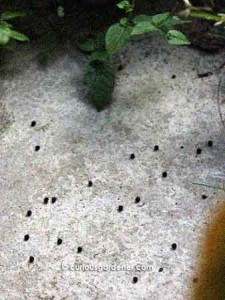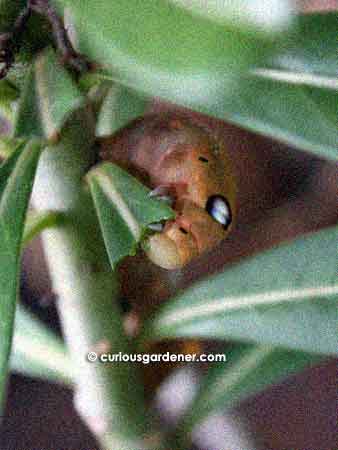Learn from my hard-won lessons. It’s caterpillar season again, and short of frequent examinations of the undersides of all the leaves of our most susceptible plants, it’s really difficult to find and remove offending caterpillars until they’ve already done significant damage to our plants.
As I’ve bemoaned in the past, our caladiums seem to be a favorite meal of caterpillars. It must be the nice, big juicy leaves that attract the butterflies or moths that lay their eggs on the plants. When I can, I turn the leaves over to look for those small, round caterpillar eggs. Oddly enough, they’re easier to see than hatched caterpillars are. Once the caterpillars are out, however, it’s almost impossible to see them as they have great colour camouflage to blend in with their surroundings.
It struck me recently how I could possibly spot the caterpillars a little sooner…
If I were Grissom from CSI, I’d tell you to look for the evidence:

Looks like someone has dropped papaya seeds on the ground, but nope, those are the droppings from a matured caterpillar!

Our adenium plant has been the latest victim of at least one voracious caterpillar. Lucky it's a hardy plant.
…caterpillar droppings.
Small and young caterpillars leave tiny black dots of their droppings peppered on the leaves beneath where they’re feeding.
Bigger caterpillars leave more noticeable evidence, especially on the ground. By the time you see droppings of this size, however, it means the caterpillar is pretty darn big, and has probably already gone into cocoon mode – and you may not have much of a plant left!
Anyway, I hope this tip helps you to avoid major caterpillar problems.


By the time I see those thingys, it’s like u said, the size of papaya seeds. Difficult to spot but not impossible. They are very strong and clingy. I used a pair of pliers to pull them away and some were as big as a pinky. They attack my tomatoes, mostly. When the tomato leaves turn yellow, I start looking …….
I ease a spade between the caterpillar and the plant. It’s broad enough that they can’t get hold of the plant again. Then I transport them on the spade to the lawn, usually, or simply far away from their target plant. Once in a while, we keep them just to see what moth/butterfly they eventually become.